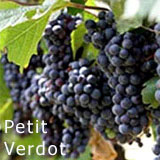The Petit Verdot grape variety is one of the six approved grapes for making red wines in the Bordeaux region of France. Petit Verdot is thought to be native to western Bordeaux, likely present in the Medoc area well before Cabernet Sauvignon and probably more widely grown. Today - Petit Verdot is the least known and least grown of the Bordeaux red varieties.
It is usually used as you would use a spice in cooking because a little goes a long way. Petit Verdot will often be blended as little as 1% to 5% of the total wine in order to take advantage of some of its most dominant characteristics. Petit Verdot has a very deep purple colour and a strong tannin structure. It is usually used to impart these features to the wine into which it is blended. Because Petit Verdot tends to ripen late in the season and is often lost to rains during harvest, it is following another red variety, Carmenere, into near extinction in the Bordeaux region. The name Petit Verdot means 'little green,' a reference to the difficulties of growing this variety.
When it does ripen, when added in small amounts, it does add excellent, complimentary tannin, colour and flavour to the other red grapes in the blend. It has attracted attention among winemakers in the New World, where it ripens more reliably and has been made into single varietal wine.
Planted in suitable climes and properly cultivated, the fruit develops in relatively small winged clusters, loosely filled with round, dark red-to-black, relatively thick-skinned, berries.
Petit Verdot's reluctant cooperation in the vineyard is likely why it is not more prevalent. The aroma of Petit Verdot includes cigar box, smoke, leather and earth tones. In addition to violet and leather, Petit Verdot flavours can include peppers, spices, smoke and minerals. Petit Verdot is not recommended for those who enjoy a fruity wine: long aging in oak barrels can also fade its fruit flavours. Petit Verdot is also grown in Italy, Spain, California, Australia, Chile and Argentina with good success.










